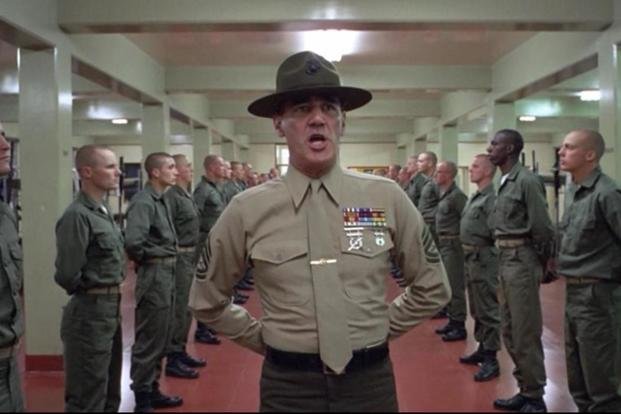Film Review of Stanley Kubrick’s “Full Metal Jacket”
Full Metal Jacket is a war film that takes on the Vietnam War by creating a jarring experience for the viewer. Events in the film range anywhere from the brutality of boot camp to the Tet Offensive. As the movie progresses, the troops eventually graduate from basic training into the army and the audience gets to witness the hardships and the perversion that they face in combat.
Full Metal Jacket approaches the Vietnam War in a deranged light. Stanley Kubrick, the film’s director, overlaps extremely violent scenes and images with everyday and commonplace music. While one could argue that the way Kubrick addresses the film is counterproductive to the goal of presenting the audience with an accurate war film on Vietnam, one could also argue that his approach allows the audience to understand the absurdity of war by including different combinations of songs and scenes in the film. Kubrick’s artistic interpretation of Vietnam and his inclusion of vast amounts of graphic violence overlaid with novelty songs of the time period present the argument that the young soldiers seen in the film do not belong in Vietnam. The audience gets to witness the inclusion of popular music of the 1960’s over certain scenes, the editing combination of the first and second halves of the film, and a scene depicting Kubrick’s idea of the absurdity of the Vietnam War.
When Kubrick plays upbeat songs over grotesque violence it creates conflicting feelings because half of the audience’s mind is enjoying the music while the other half is witnessing the complete destruction of war. By pairing these things together, the audience is left with an almost awkward feeling of enjoying the war. For example, when Kubrick introduces the song “Surfin’ Bird,” the audience sees a helicopter land, but once it lands, one then realizes that the helicopter is for grossly wounded troops who are carried on to be evacuated. The song was also made popular by its usage in the show Family Guy.
The inclusion of 1960’s rock over scenes of violence shows the absurdity of the Vietnam War. In a Cineaste article of Full Metal Jacket, Christopher Sharrett argues that the Kubrick’s inclusion of the rock songs popular to the time period that Kubrick uses only suggest the soundtrack is simply, “banal” and “lacks political efficacy.” By saying this, Sharrett condemns Kubrick for his music choices. However, the popular rock music of the time period actually works as a political tool by giving the audience the idea that this music characterizes the youth of the soldiers. The music seems inappropriate to include but it shows that these soldiers are out of place in Vietnam. Therefore, it is inappropriate to force these soldiers to fight in a war that is unclear and detrimental to them.
The troops forced through basic training are unprepared for the pressure of war. The first half of the movie focuses primarily on the relationships of the soldiers in basic training and their interactions with each other and the drill sergeant.
The drill sergeant has an overbearing job and personality and he consistently challenges the abilities of the soldiers under his command both mentally and physically. One soldier in particular, Private Pyle, breaks under the pressure. The movie starts depicting Pyle as an almost childlike giant who always looks on the brighter side of things. His demeanor slowly changes as the drill sergeant continues to criticize his every move and he eventually snaps and kills the drill sergeant. This example relates to Kubrick’s artistic interpretation of Vietnam by showing what happens to unstable and young soldiers who break under pressure.
Instead of showing resolution after Pyle kills the drill sergeant, Kubrick adjoins the first half with an abrupt second half showing the men absorbed by combat which is a motion to surprising the audience with unexpected violence. Sharrett calls this fusion, “a gesture aimed at demolishing audience empathy and involvement.” Sharrett believes the combination of the first half to the second half is too crude for the audience to comprehend.
The abrupt editing of the two halves depicts Kubrick’s artistic interpretation of the war because it shows the troops were unprepared for combat and should not belong in Vietnam. The shift forces the audience to adapt to the violent scenes of Vietnam in the second half which actually invokes empathy since the soldiers themselves had no way of emotionally preparing for their entrance into combat.
In the second half of the movie we follow one of the main characters, Joker, a war correspondent. One of the groups of soldiers he comes across is particularly jaded to the violence of Vietnam because of thee entertainment brought by the dehumanization of a dead Vietcong corpse. One soldier even goes so far as to pose with the dead body when the cameraman shows up. The movie presents the youth and disturbed foolishness of the troops as they create a story around the dead Vietcong soldier.
It could be argued that this group of soldiers seems to dehumanize the dead corpse in order to cope with the war. By including this scene, Kubrick shows the absurdity of the Vietnam War found in this barbaric setting.
One could argue that this inclusion of a strange and unnecessary scene detracts from the message of the film. It shows how jaded the troops are to the grotesque violence of war when in reality, these young troops shouldn’t be accustomed to the horrors most would have witnessed in Vietnam.
The movie captures the perversion of war along with the soldiers’, interactions and emotions towards the horrors they face. The array of different combinations between the music and the film, allow for the audience to understand a soldier’s path through the war. “Full Metal Jacket” is a vital source of information concerning Vietnam and deserves to be recognized as one of the greatest Vietnam movies for its unique take on the war.




